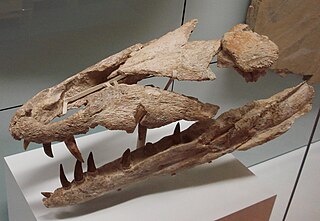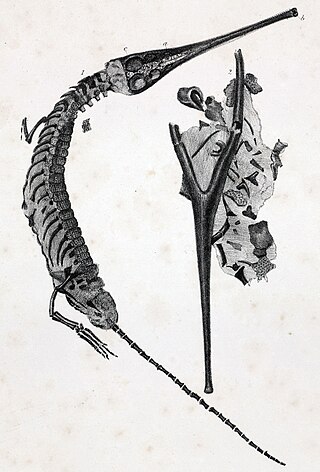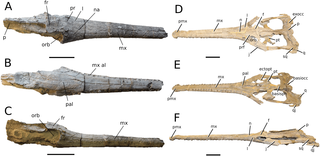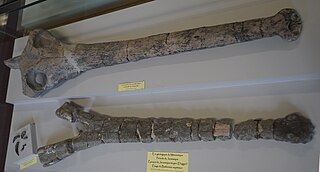
Machimosaurus is an extinct genus of machimosaurid crocodyliform from the Late Jurassic and Early Cretaceous. The type species, Machimosaurus hugii, was found in Switzerland. Other fossils have been found in England, France, Germany, Portugal, Switzerland and Tunisia. Machimosaurus rex is the largest named teleosauroid and thalattosuchian, with an estimated length of up to 7.15 m (23.5 ft). Machimosaurus is the largest known crocodyliform of the Jurassic.

Thalattosuchia is a clade of mostly marine crocodylomorphs from the Early Jurassic to the Early Cretaceous that had a cosmopolitan distribution. They are colloquially referred to as marine crocodiles or sea crocodiles, though they are not members of Crocodilia and records from Thailand and China suggest that some members lived in freshwater. The clade contains two major subgroupings, the Teleosauroidea and Metriorhynchoidea. Teleosauroids are not greatly specialised for oceanic life, with back osteoderms similar to other crocodyliformes. Within Metriorhynchoidea, the Metriorhynchidae displayed extreme adaptions for life in the open ocean, including the transformation of limbs into flippers, the development of a tail fluke, and smooth, scaleless skin, and probably gave live birth, seemingly uniquely among archosaurs.

Teleosauridae is a family of extinct typically marine crocodylomorphs similar to the modern gharial that lived during the Jurassic period. Teleosaurids were thalattosuchians closely related to the fully aquatic metriorhynchoids, but were less adapted to an open-ocean, pelagic lifestyle. The family was originally coined to include all the semi-aquatic thalattosuchians and was equivalent to the modern superfamily Teleosauroidea. However, as teleosauroid relationships and diversity was better studied in the 21st century, the division of teleosauroids into two distinct evolutionary lineages led to the establishment of Teleosauridae as a more restrictive family within the group, together with its sister family Machimosauridae.

Cricosaurus is an extinct genus of marine crocodyliforms of the Late Jurassic. belonging to the family Metriorhynchidae. The genus was established by Johann Andreas Wagner in 1858 for three skulls from the Tithonian of Germany. The name Cricosaurus means "Ring lizard", and is derived from the Greek Krikos- ("ring") and σαῦρος -sauros ("lizard"). It was a relatively small reptile, with C. suevicus and C. araucanensis measuring 2 m (6.6 ft) and 3.2 m (10 ft) in total body length, respectively.

Steneosaurus is a dubious genus of teleosaurid crocodyliform from the Middle or Late Jurassic of France. The genus has been used as a wastebasket taxon for thalattosuchian fossils for over two centuries, and almost all known historical species of teleosauroid have been included within it at one point. The genus has remained a wastebasket, with numerous species still included under the label ‘Steneosaurus’, many of which are unrelated to each other.

Aeolodon is an extinct genus of teleosaurid crocodyliform reptile from the Late Jurassic (Tithonian) of Germany and France that was initially named as a species of Crocodylus in 1814. Although previously synonymized with Steneosaurus, recent cladistic analysis considers it distantly related to the Steneosaurus type species and the type species is A. priscus, named in 1830 and described in 2020.

Sericodon is an extinct genus of teleosaurid crocodyliform from the Late Jurassic (Tithonian) of Germany and Switzerland. The genus contains a single species, S. jugleri. Sericodon was placed in 'Clade T' (Aeolodontinae) and was found to be the sister taxon to Bathysuchus, another teleosaurid.

Metriorhynchoidea is an extinct superfamily of thalattosuchian crocodyliforms from the Early Jurassic to the Early Cretaceous of Europe, North America and South America. Metriorhynchids are fully aquatic crocodyliforms. Named by Fitzinger, in 1843, it contains the basal taxa like Teleidosaurus, Zoneait and Eoneustes and the family Metriorhynchidae. An unnamed taxon is known from Chile.

Macrospondylus is an extinct genus of machimosaurid teleosauroid crocodyliform from the Early Jurassic (Toarcian) of Europe. Fossils are known from the Posidonia Shale of Germany, the Whitby Mudstone of the United Kingdom, and the "schistes bitumineux" of Luxembourg.

Geosaurinae is a subfamily of metriorhynchid crocodyliforms from the Middle Jurassic to the Early Cretaceous of Europe, North America and South America. Named by Richard Lydekker, in 1889, it contains the metriorhynchids Suchodus, Purranisaurus, Neptunidraco, Tyrannoneustes, Torvoneustes, Dakosaurus, Geosaurus and Plesiosuchus. The last five taxa form a tribe within Geosaurinae, the Geosaurini. Geosaurinae is one of two subfamilies of Metriorhynchidae, the other being Metriorhynchinae.

Bathysuchus is an extinct genus of teleosaurid thalattosuchian from Late Jurassic (Kimmeridgian) deep water marine deposits in England and France. Bathysuchus displays features that suggest it was more pelagic than other teleosaurids, including smoother skull bones and reduced armour plating, similar to the fully marine metriorhynchids. This was possibly an adaptation to rising sea levels during the Kimmeridgian, as its earlier relatives such as Teleosaurus were suited for shallow coasts and lagoon environments.

Lemmysuchus is a genus of machimosaurid thalattosuchian from the Middle Jurassic Callovian of England and France. Like many other teleosauroids from Europe, it has had a convoluted taxonomic history.

Indosinosuchus is a genus of teleosaurid neosuchian that lived during the Late Jurassic or Early Cretaceous in what is now Thailand. It contains two species, the type species I. potamosiamensis and I. kalasinensis, both recovered from the lower Phu Kradung Formation. It is unique among teleosauroids as it is the only named genus known from a freshwater environment, while most other members of the group are marine. Indosinosuchus is placed in the family Teleosauridae, but has a relatively robust skull that bears resemblance to members of the Machimosauridae. Biomechanical analysis of its mandible and teeth suggest that it would have had a substantial bite force comparable to animals like Lemmysuchus. The two Indosinosuchus species however differ in the speed at which they could open and close their jaws, impacting their respective ecology and possibly explaining how they coexisted in the same environment. All known specimens of this genus were recovered from a single locality, which has been interpreted as a mass death site, possibly caused by a drought or flash flood. The precise age of Indosinosuchus is unclear, as the vertebrate fossils of the Phu Kradung Formation support a Late Jurassic age, while palynological data suggests an Early Cretaceous (Berriasian) age.

Yvridiosuchus is an extinct genus of machimosaurid crocodyliform from the Middle Jurassic (Bathonian) Cornbrash Formation of England and the Sommet de la Grande Oolithe, Calvados, France. The type and only known species is Y. boutilieri. Yvridiosuchus is the oldest known member of Machimosaurini, a clade of large, predatory machimosaurids with powerful jaws and teeth. Yvridiosuchus was named on the basis that it has characteristics of both earlier machimosaurids and the derived machimosaurins, such as conical, blunt teeth. It co-existed with the more generalist machimosaurid Deslongchampsina.

Teleosauroidea is an extinct superfamily of thalattosuchian crocodyliforms living from the Early Jurassic to the Early Cretaceous. It is phylogenetically defined by Mark T. Young and colleagues in 2024 as "the largest clade within Thalatttosuchia containing Teleosaurus cadomensis, but not Metriorhynchus brevirostris. This group contains two main families, the more piscivorous and gracile Teleosauridae and the more macropredatory and robust Machimosauridae.

Neosteneosaurus is a genus of machimosaurid, known from the Middle Jurassic Oxford Clay of the UK, and Marnes de Dives, France. The type species, N. edwardsi, was originally named as a species of Steneosaurus in 1868, but was moved to its own genus in 2020. Steneosaurus durobrivensis and Steneosaurus hulkei are considered junior synonyms.

Andrianavoay is an extinct genus of teleosauroid from the Bathonian, probably from the Isalo III Formation of Madagascar.

Clovesuurdameredeor is an extinct genus of machimosaurid teleosauroid from the Bathonian Cornbrash Formation of England.

Seldsienean in an extinct genus of machimosaurid thalattosuchian from the Middle Jurassic of England and France. It is known from the Calcaire de Caen and the Cornbrash Formation.

Turnersuchus is an extinct genus of thalattosuchian, a group of marine crocodylomorphs, from the Pliensbachian of the United Kingdom. It is the oldest diagnostic member of Thalattosuchia and was also found to be the group's most basal member, being situated outside the two major groups Metriorhynchoidea and Teleosauroidea. Subsequently, this genus is considered to be of great importance to understanding the relationship between thalattosuchians and other crocodylomorphs as well as their rapid diversification during the early Jurassic. Turnersuchus is a monotypic genus, meaning it includes only a single species, Turnersuchus hingleyae.





















